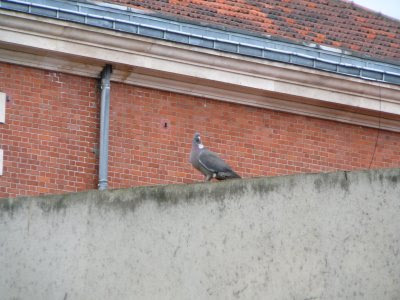The apartment was in an architecturally dismal but actually comfortable 60s high-rise on the totally un-photogenic rue de Vaugirard (the longest street in Paris). The apartment was in the rear of the building and its small balcony overlooked a green courtyard that was enclosed by some other high-rises and by the tall brick wall of the Institut Pasteur. We could see the roofs of the 19th Century institute buildings above the wall.
A flock of pigeons occupied the top of the wall, the roofs of the institute and the vegetation of the courtyard. These were not your raggle-taggle everyday city pigeons, subsisting on a diet of used chewing gum and Snickers wrappers. No! These were huge, sleek, robust pigeons with white markings on their necks and wings. Their deep calls echoed between the buildings in the early morning and they apparently let none of their lesser pigeon brethren in their territory.
I didn’t know what they were but enjoyed speculating that they were a new evolutionary branch thrown up by Paris’s enormous pigeon population or, even more fun to speculate about, an experiment from the institute next door. The truth was simpler but still interesting.
At the end of our Paris visit we took a train to Tours, rented a car there and headed off for Chinon. As soon as we got out into the country, we began to see the “Super Pigeons” everywhere. It turns out that they are the Wood Pigeon (Columba Palumbus) and are a very numerous inhabitant of rural woods and fields in a large part of Europe. Of course the question remains as to why that flock in Paris abandoned their usual habitat and colonized that particular courtyard. I’m still entertaining the Institut Pasteur experiment theory.


No comments:
Post a Comment